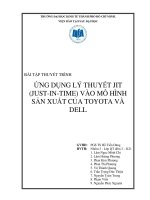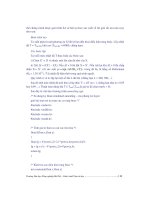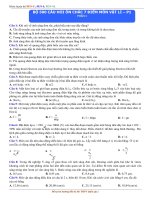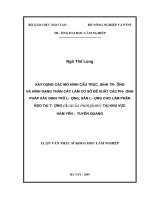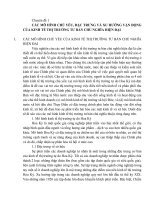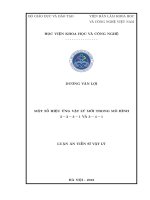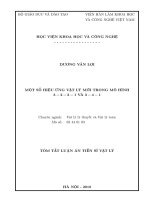Các hiệu ứng vật lý mới trong các mô hình 3 2 3 1 và 3 3 3 1 tt tiếng anh
Bạn đang xem bản rút gọn của tài liệu. Xem và tải ngay bản đầy đủ của tài liệu tại đây (3.33 MB, 25 trang )
MINISTRY OF EDUCATION
VIETNAM ACADEMY
AND TRAINING
OF SCIENCE AND TECHNOLOGY
GRADUATE UNIVERSITY SCIENCE AND TECHNOLOGY
- - - - - - - - *** - - - - - - - -
NGUYEN THI NHUAN
SOME NEW PHYSICAL EFFECTS
IN THE 3 − 2 − 3 − 1 AND 3 − 3 − 3 − 1 MODELS
Major:
Code:
Theoretical and Mathematical Physics
9 44 01 03
SUMMARY OF PHYSICS DOCTORAL THESIS
Hanoi - 2019
INTRODUCTION
1. The urgency of the thesis
The standard model (SM )of particle physics is based on two principal theories including electroweak theory with the SU (2)L × U (1)Y gauge symmetry
and QCD theory with SU (3)c gauge symmetry. The SM describes elementary
particles which create matter and their interactions which make the entire
universe. In the SM, three interactions of particles are described successfully:
strong interactions, electromagnetic interactions and weak interactions. Many
predictions of the SM such as: the existence of W ± , Z boson, quark c, t, neutral
currents ... have been verified with high fidelity by experiments. W, Z found
in 1981 with the masses measured as the model proposed. There are many
ways to expand SM such as introducing the spectral particles, extend gauge
group,etc. Therefore, we would suggest two expansion models: the 3 − 2 − 3 − 1
and the 3−3−3−1 models. The 3−2−3−1 model is based on the gauge group
SU (3)C ⊗ SU (2)L ⊗ SU (3)R ⊗ U (1)X . The 3 − 2 − 3 − 1 model solves the neutrino masses problem, provides naturally candidate for dark matter, indicates
the existence of FCNC at the approximate tree caused by the gauge bosons
and Higgs, explains why are there three fermion generations. The 3 − 3 − 3 − 1
model is based on the gauge group SU (3)C ⊗ SU (3)L ⊗ SU (3)R ⊗ U (1)X . It
unifies both the left-right and 3-3-1 symmetries, so it inherits all the good features of the two models. Therefore, the 3 − 3 − 3 − 1 model solves problems of
fermion generation numbers, neutrino masses problems, dark matter problems,
parity symmetry in electroweak theory. In particular, the model predicts lepton flavor violation of the charged lepton. Especially, on 4/7/2012, a particel
was discovered at the Large Hadron Collider (LHC) located at the European
Nuclear Research Center using two independent detectors, A Toroidal LHC
ApparatuS (ATLAS) and Compact Muon Solenoid (CMS), with a mass measured about 125 − 126 GeV. This particel has characteristics identical to the
1
boson Higgs predicted by SM that has not been found previously. It was the
last piece for the picture called "Standard Model" to be completed. It can be
stated that the SM of particle physics is very successful describing interactions
in the Universe. However, the SM model can not explain some observed figures
in the Universe and recent experimental results. Specifically: Why do neutrinos have mass? SM does not identify the candidates for dark matter particles.
SM does not explain some abnormal decay channels of mesons, higgs ... SM
also does not answer the questions: Why are there three fermion generations?
Why is asymmetrical between matter and antimatter? Why is mass graded in
the fermion spectrum? ... So, an expansion is necessary.
For the mentioned reasons, we choose the subject "Some new physics effects
in the 3 − 2 − 3 − 1 and 3 − 4 − 1 models".
2. The objectives of the thesis
• Resolve the neutrino mass problem. Parameterize the parameters in the
model 3 − 2 − 3 − 1 to seek for dark matter for each version of the model
with q = 0 and q = −1. Research for Z1 and Z1 at LEPII and LHC.
• Survey in detail the mass of gauge bosons, Higgs bosons, flavor-changing
neutral current in the model 3 − 3 − 3 − 1 and calculate the branch ratio
of the decay process mu → eγ, µ → 3e in the model.
3. The main contents of the thesis
• Overview of SM, flavor-changing neutral current, neutrino masses and
dark matter problems in SM.
• Investigate the 3 − 2 − 3 − 1 model with any charge of new leptons,
neutrino masses, and identify dark matter candidates in the model and
search for dark matter by the method direct search.
• Investigate the model 3 − 3 − 3 − 1 with any charge of new leptons, gauge
boson masses, Higgs mass, FCNCs, cLFV in decay process µ → eγ,
µ → 3e.
2
CHAPTER 1. OVERVIEW
1.1. The Standard Model
SM describes strong, electromagnetic and weak interactions based on the
gauge symmetry group SU (3)C ⊗SU (2)L ⊗U (1)Y (3−2−1). In particular, the
gauge group SU (3)C describes strong interaction, gauge group SU (2)L ⊗U (1)Y
describes weak electrical interaction. The electric charge operator: Q = T3 +
Y /2. The particles in SM are arranged under the gauge group as follows:
Leptons:
νaL
eaL
ψaL =
∼ (1, 2, −1),
eaR ∼ (1, 1, −2),
a = 1, 2, 3.
(1.1)
Quarks:
QaL =
uaR ∼
uaL
daL
3, 1,
∼
4
,
3
3, 2,
1
,
3
daR ∼
3, 1, −
2
,
3
(1.2)
where a is the generation index.
The SU (3)C ⊗ SU (2)L ⊗ U (1)Y gauge group is broken spontaneously via
a single scalar field,
φ=
ϕ+
ϕ0
=
ϕ+
v+h+iG
Z
√
2
∼ (1, 2, 1).
(1.3)
After SSB, the received gauge bosons are:
1
Aµ = sW A3µ + cW Bµ , Zµ = cW A3µ − sW Bµ , Wµ± = √ (A1µ ∓ iA2µ ),
2
gv
gv
mA = 0, mZ =
, mW ± =
.
(1.4)
2cW
2
3
The Yukawa interaction:
i
¯ iL φdj + huij Q
¯ iL (iσ2 φ∗ )uj + H.c.,
− LY = heij ψ¯L
φejR + hdij Q
R
R
(1.5)
for fermion mass matrices: Meij = heij √v2 , Mdij = hdij √v2 , và Muij = huij √v2 .
Diagonalization of these mass matrices will determine the physical fermion
states and their masses.
1.2. GIM mechanism and CKM matrix
1.2.1. GIM mechanism
If only three quarks exist: u, d, s with left-handed quarks arranged to doublet of SU (2)L group:
Q1L
=
u
dθc
=
L
uL
cosθc dL + sinθc sL
,
(1.6)
and right-handed quarks arranged to singlet of SU (2)L group: uR , dθcR , sθcR
(θ is flavor mixing angle, called Cabibbo angle), hence we have high flavor
changing neutral current. This contradicts experiment.
In 1970, Glashow, Iliopuolos and Maiani (GIM) proposed a new mechanism
to solve this problem by introducing the two quark doublet which includes the
four quark, which is now called the charm quark c,
Q1L =
uL
cosθc dL + sinθc sL
uR ,
, Q2L =
cR ,
uL
cosθc sL − sinθc dL
dθc R ,
,
sθc R .
(1.7)
and then we have no flavor changing neutral current at the tree level. Thus,
the GIM mechanism came to the conclusion: to have a small FCNCs,
there must be at least two quarks generations
1.2.2. CKM matrix
In SM, if there were only two quark generations, scientists have no CP
violation. To solve the CP symmetry violating problem, scientists supposed
the existence of the third quark generation. The expansion of the model to
three generations schemd, in order to accommodate the observed violation in
KL decay, was first proposed by Kobayashi and Maskawa in 1973. The CP
4
violation via a phase in quark mixing matrix. The quark mixing matrix has
three angles and one phase and is generalized from the Cabibbo mixing matrix
into six quarks with three quark generations represented through the 3 × 3
matrix called the Cabibobo-Kobayashi-Maskawa matrix (CKM ). In 1977, the
quark b was officially discovered, confirming the hypothesis of scientists has
accurated. It also mark proposal of Kobayashi-Maskawa that is success befor
finding the quark c of the second generation. By using three generations with
a mixing angles: θ1 , θ2 , θ3 and CP violation phase, δ introduced by Kobayashi
and Maskawa, the quark mixing matrix is as follows:
V = R1 (θ2 )R3 (θ1 )C(0, 0, δ)R1 (θ3 ),
(1.8)
Another parameterization of V is the so-called standard parameterization
which is is characterized in terms of three angles θ12 , θ23 , θ13 and a phase
δ13 as:
−iδ13
c12 c13
V = −s12 c23 − c12 s23 s13 eiδ13
s12 s23 − c12 c23 s13 eiδ13
s12 c13
c12 c23 − s12 s23 s13 eiδ13
−c12 s23 − s12 c23 s13 eiδ13
s13 e
s23 c13
c23 c13
, (1.9)
where, cij = cosθij , sij = sinθij , i, j = (1, 2, 3).
¯ 0 mixing in SM
1.2.3. K 0 − K
Since neutral kaons are the bound states of s and d quarks and their antin¯ 5 s), this mixing occur because there is a moving
¯ 0 ∼ dγ
quarks, (K 0 ∼ s¯γ5 d, K
¯ In the FCNC processes of kaons, the strangeness changes
process s¯d ↔ sd.
| S| = 2, while charge do not.
Their mass diference:
∆mK ≡ mKL − mKS
2M12 ,
(1.10)
According to Feynman rule, effective Lagrangian:
|∆S|=2
Lef f
αGF
= √
4 2πsin2 θW
∗
(Vis∗ Vid )(Vjs
Vjd )E(xi , yj )(¯
sγµ PL d)(¯
sγ µ PL d, (1.11)
i,j=c,t
5
5
where, PL = 1−γ
2 , Vis are CKM matrix elements and confficient function
E(xi , yj ) express the contributtions of two internal quarks with masses mi , mj
m2
and xi ≡ M i2 . he confficient function E(xi , xj ):
w
3 xi 3
1 9 1
3
1
) lnxi − xi [ −
−
].(1.12)
E(xi ) ≡ E(xi , xi ) = − (
2 xi − 1
4 4 xi − 1 2 (xi − 1)2
To get M1 2, we need to evaluate the matrix element of respect to kaons states:
¯ 0 = 2 f 2 m2 B,
K 0 |(¯
sγ µ Ld)|K
3 K K
(1.13)
where, fk = 160 MeV is decay constant, mK is the mass of K-meson (mK
M ) and B is the "bag-parameter", which parameterizes the ambiguity due
¯0 .
to the non-perturbative QCD effects to form the bound states K 0 and K
Hamiltonian is the mass-squared matrix reads as:
H=
δm2
2M
2
M2
δm2
2M
M
,
(1.14)
2
δm
this means M12
2M . In the case of restricted two generatiob model, noting
E(xc ) −xc với xc << 1, we get:
∆mK
sin2θc cos2θc m2c
GF
α
−√
.
B
2
MW
2 6πsin2θW
(1.15)
The contribution of SM to K-meson mass different: bea
∆mK = 0.467.10−2 /ps.
(1.16)
According to recent calculations, B = 0.72 ± 0.04, K-meson mass different: bea
∆mK = (3.483 ± 0.006)µeV = (5.292 ± 0.009).10−3 /ps.
(1.17)
Thus, there is a difference in K-meson mass between SM theory and
experiment.
6
CHAPTER 2. PHENOMENOLOGY OF THE 3 − 2 − 3 − 1
MODEL
2.1. The anomaly cancellation and fermion content
The electric charge operator: Q = T3L + T3R + βT8R + X. The right-handed
fermions are arranged as:
νaR
νaL
q−1
1
ψaL =
, (2.1)
∼ 1, 2, 1, − , ψaR = eaR ∼ 1, 1, 3,
2
3
eaL
q
EaR
u3R
u3L
q+1
1
Q3L =
∼ 3, 2, 1,
, Q3R = d3R ∼ 3, 1, 3,
, (2.2)
6
3
2
d3L
q+
J3R 3
dαR
uαL
1
q
, QαR = −uαR ∼ 3, 1, 3∗ , − , (2.3)
QαL =
∼ 3, 2, 1,
6
3
dαL
−q− 1
JαR 3
q+ 2
q
EaL
∼ (1, 1, 1, q), J3L 3 ∼ 3, 1, 1, q +
2
1
−q− 1
, JαL 3 ∼ 3, 1, 1, −q −
, (2.4)
3
3
2.2. Symmetry breaking schemes
To break the gauge symmetry and generate the particle masses appropriately, the scalar content is introduced as
S
=
φ
=
−q
+
S12
S13
−q−1
0
S22
S23
−q
0
S11
−
S21
φ1
−q−1
φ2
∼
φ03
∼
1, 1, 3, −
7
1, 2, 3∗ , −
2q + 1
3
,
2q + 1
6
,
(2.5)
(2.6)
Ξ
Ξ011
=
Ξ−
√12
2
Ξq13
√
2
Ξ−
√12
2
−−
Ξ22
Ξq−1
23
√
2
Ξq13
√
2
Ξq−1
23
√
2
2q
Ξ33
∼
1, 1, 6,
2(q − 1)
3
,
(2.7)
with vacuum expectation values (VEVs),
S
1
√
2
=
u 0
0 v
0
0
0
1
φ = √ 0 ,
2
w
,
Λ 0 0
1
Ξ = √ 0 0 0(2.8)
.
2
0 0 0
The spontaneous symmetry breaking is implemented through three possible
ways.
The first way assumes w
Λ
u, v, and the gauge symmetry is broken
as:
w
SU (3)C ⊗ SU (2)L ⊗ SU (3)R ⊗ U (1)X −→ SU (3)C ⊗ SU (2)L ⊗ SU (2)R ⊗ U (1)B−L
u,v
Λ
−→ SU (3)C ⊗ SU (2)L ⊗ U (1)Y ⊗ WP −→ SU (3)C ⊗ U (1)Q ⊗ WP .
The second way assumes Λ
as:
w
u, v, and the gauge symmetry is broken
SU (3)C ⊗ SU (2)L ⊗ SU (3)R ⊗ U (1)X
Λ
→ SU (3)C ⊗ SU (2)L ⊗ SU (2)R ⊗ U (1)X ⊗ WP
u,v
−→ SU (3)C ⊗ SU (2)L ⊗ U (1)Y ⊗ WP −→ SU (3)C ⊗ U (1)Q ⊗ WP .
w
The last case is w ∼ Λ, and the gauge symmetry is broken as:
w,Λ
SU (3)C ⊗ SU (2)L ⊗ SU (3)R ⊗ U (1)X −→ SU (3)C ⊗ SU (2)L ⊗ U (1)Y ⊗ WP
u,v
−→ SU (3)C ⊗ U (1)Q ⊗ WP .
Conclusion: every symmetry breaking scheme leads to the matter parity WP as
a residual gauge symmetry, which is not commuted with the beginning gauge
symmetry. The normal particles have WP = 1. They are particles in SM. The
wrong particles have WP = P + or P − . They could be dark matter particles.
2.3. Research results of phenomenology of the 3 − 2 − 3 − 1 model
2.3.1. Neutrino mass and lepton flavor violation
Neutrino mass
The Yukawa interaction:
†
R ¯c
†
¯ aL SΨbR + hE
¯
L ⊃ hlab Ψ
ab EaL φ ΨbR + hab ΨaR Ξ ΨbR + H.c.
8
(2.9)
The neutral leptons get Dirac masses via u and right-handed Majorana masses
c
via Λ, given in the basis (νL , νR
) as follows
0
hl u
(hl )T u 2hR Λ
1
Mν = − √
2
.
(2.10)
Because of u
Λ, the type I seesaw mechanism applies and the active neutrinos (∼ νL ) obtain small Majorana masses as
mν
u2 l R −1 l T
√ h (h ) (h ) .
2 2Λ
(2.11)
√
Using hl = − 2ml /v and mν ∼ 0.1 eV, we evaluate
1
h ∼√
2
R
u
v
2
ml
GeV
2
1010 GeV
.
Λ
(2.12)
The model predicts Λ ∼ 1010 GeV in the perturbative limit hR ∼ 1. Even
relaxing the weak scale ratio as u/v = 1000–0.001, the B − L breaking scale
is Λ = 1016 –104 GeV.
Lepton flavor violation
The processes like µ → 3e happen at the tree level by the exchange of
doubly-charged scalar (Ξ±±
22 ). Branch ratio of the process µ → 3e:
Br(µ− → e+ e− e− )
Γ(µ− → e+ e− e− )
1
2 R 2
=
|hR
eµ | |hee | ,
2
4
−
−
Γ(µ → e νµ ν¯e )
GF mΞ22
(2.13)
−3
In order to Br(µ− → e+ e− e− ) < 10−12 , we choose: hR
÷ 1 so
ee,eµ = 10
→mΞ22 = 1 ÷ 100T eV .
The processes like µ → eγ does not exist at the approximate tree level.
These processes are induced by one-loop corrections by exchange of doublycharged scalar Higgs. Branch ratio of the process µ → eγ:
Br(µ → eγ)
α 25 |(hR† hR )12 |2
,
48π 16 MΞ422 G2F
(2.14)
where, α = 1/128. Taking the experimental bound Br(µ → eγ) < 4.2 × 10−13
leads to mΞ22 = 1–100 TeV for |(hR† hR )12 | = 10−3 –10, respectively. Comparing to the previous bound, this case translates to hR
0.03–3.16.
eτ,µτ
9
2.3.2. Search for Z1 and Z1 at colliders
LEPII
The LEPII at CERN searched for new neutral gauge boson signals that
mediate the processes such as e+ e− → (Z1 , Z1 ) → f f¯, where f is ordinary
fermion in the final state. From the neutral currents, we obtain effective interactions describing the processes,
Leff
=
2
gL
e¯γ µ (aIL (e)PL + aIR (e)PR )e f¯γ µ (aIL (f )PL + aIR (f )PR )f
2
2
cosW mI
=
2
gL
c2W
Z
Z
Z1
1
aZ
aL1 (e)aL1 (f )
L (e)aL (f )
+
m2Z1
m2Z
(¯
eγ µ PL e)(f¯γµ PL f )
1
+(LR) + (RL) + (RR),
(2.15)
The cross-section for dilepton final states f = µ:
2
1
gL
2
2
4cW tR + β 2 t2X
(s sW + c cW βtX )2
(c sW − cW s βtX )2
+
m2Z 2
m2Z
<
1
, (2.16)
(6 TeV)2
1
1
we get: mZ1 > O(1) TeV.
LHC
The LEPII at CERN searched for new neutral gauge boson signals that
mediate the processes such as pp → Z1 → f f¯., where f is ordinary fermion in
the final state. The cross-section for dilepton final states f f¯:
1
dLqq¯
σ(pp → Z1 → f f¯) =
σ
ˆ (q q¯ → Z1 ) × Br(Z1 → f f¯). (2.17)
2
3
dmZ1
q=u,d
10
10
2% Width
4
1
Width
8% Width
0.1
16% Width
32%Width
Model: Β=-1/ 3
+
1
3
1
ll
Model : Β
Σ pp
0.01
0.001
10
4
10
5
1000
2000
3000
m
4000
5000
1
Hình 2.1: The cross-section σ(pp → Z1 → l¯l) [pb] as a function of mZ1 [GeV],
where the points are the observed limits according to the different widths
extracted at the resonance mass in the dilepton final state using 36.1 fb−1 of
√
proton-proton collision data at s = 13 TeV with ATLAS detector. The star
√
and plus lines are the theoretical predictions for β = ±1/ 3, respectively.
Experimental results show that a negative signal for new high-mass phenomena in the dilepton final state. It is converted into the lower limit on the
√
Z1 mass, mZ1 > 4 TeV, for models with β = ±1/ 3.
2.3.3. Dark matter phenomenology
A dark matter particle must satisfy the following conditions: Electrically
neutral, colorless, the lightest mass of parity odd particles and the dark matter
0.1pb
relic density agreement with the experiment Ωh2
0.11. In this
<σvrel >
model, the dark matter candidates are:
• q =0: E1 , H6 , H7 , XR
• q = -1: H8 , YR
E1 Fermion dark matter
Dominated annihilator channels of E1 :
− +
E1 E1c → νν c , l− l+ , να ναc , lα
lα , qq c , ZH1 .
(2.18)
where the first two productions have both t-channel by respective XR , YR and
s-channel by Z1 , Z1 , while the remainders have only the s-channel. There may
exist some contributions from the new scalar portals, but they are small and
neglected. There is no standard model Higgs or Z portal.
In Fig. 2.2 we display the dark matter relic density as a function of its mass.
It is clear that the relic density is almost unchanged when mZ1 changes. he
stabilization of dark matter yields only a Z1 resonance regime. For instance,
11
w = 9 TeV, the dark matter mass region is 1.85 < mE1 < 2.15 TeV, given that
it provides the correct abundance.
10
mZ1 = 4.13 TeV
mZ2 = 81 TeV
Z1 Resonance
h2
1
0.1
0.01
500
w = 9 TeV
= 100 TeV
1000
1500
2000
mE1 GeV
2500
3000
Hình 2.2: The relic density of the fermion candidate as a function of its mass,
mE 0 , in the limit Λ
w, ở đây Z1 ≡ Z1 và Z2 ≡ Z1 .
10
44
10
45
10
46
10
47
10
48
500
Events day kg
Σ E1
Xe
cm2
Currently, there are three ways to search for dark matter: search at the
LHC, direct search and indirect search. The three methods have their own
strengths. Using Micromegas software, we drawn a graph for the direct search
process. The direct detection experiments measure the recoil energy deposited
1000
1500
2000
mE1 GeV
2500
0.001
10
4
10
5
10
3000
6
500
1000
1500
2000
mE1 GeV
2500
3000
Hình 2.3: The scattering cross-section (left-panel) and the total number of
events/day/kg (right-panel) as functions of fermion dark matter mass.
by the scattering of dark matter with the nuclei. This scattering is due to the
interactions of dark matter with quarks confined in nucleons. Fig. 2.3 shows
that the predicted results are consistent with the XENON1T experiment since
the dark matter mass is in the TeV scale.
H6 scalar dark matter
The scalar H6 transforms as a SU (2)L doublet. The field H6 can annihilate
into W + W − , ZZ, H1 H1 and f¯f since its mass is beyond the weak scale. The
12
annihilation cross-section is given by:
α
150 GeV
σv
2
2
600 GeV
mH6
x × 1.354 TeV
mH6
+
2
,
(2.19)
where x ∼ λSM 0.127. In order for H6’s density to reach the thermal abundance density or below the thermal abundance density, its mass must meet
mH6 < 600 GeV.However, when mH6 > 600 GeV is large, the scalar dark matter can (co)annihilate into the new normal particles of the 3-2-3-1 model via
the new gauge and Higgs portals similarly to the 3-3-1 model, and this can
reduce the abundance of dark matter to the observed value, so H6 is not a
good candidate for dark matter.
H7 scalar dark matter
Since H7 is a singlet of the SU (2)L group, it has only the Higgs (H1,2,3,4,6,7 ),
new gauge, and new fermion portals. The annihilation products can be the
standard model Higgs, W, Z, top quark, and new particles. we chose the the
parameter space to the primary annihilation channels is Higgs in SM through
the new Higgs ports.
H7
h
H7
H6
H7
h
H7
h
H7
h
H7
h
H7
H7
H3
H7
h
H7
h
H7
H4
h
H7
h
H7
h
H7
h
h
H7
h
H2
h
h
Hình 2.4: Diagrams that describe the annihilation H7∗ H7 → H1 H1 via the
Higgs portals, where and in the text we sometimes denote h ≡ H1 for brevity.
We calculate the total amplitude of diagrams Feymman and build the expression of the dark matter relic density as:
Ωh2
mH7
0.1
1.354 TeV
• mH7
m2H3
λ5 λ6
¯
λ−
+λ
2(λ1Ξ + λ2Ξ )
4m2H7 − m2H3
2
−2
. (2.20)
mH3 thì mật độ tàn dư:
2
Ωh
0.1
λeff
13
mH7
× 1.354 TeV
2
.
(2.21)
Để Ωh2
graph:
0.11 thì: mH7 ≤ |λeff | × 1.354TeV ∼ 1.354 TeV, We draw the
BLE
0.20
h2
P-UN
STA
0.15
WIM
0.10
0.05
0.00
0.5
1.0
1.5
2.0
mH
7
2.5
3.0
3.5
TeV
Hình 2.5: The relic density depicted as a function of the scalar H7 mass.
In figure 2.5: The straight line is experimental line correspond to Ωh2
0.11, the resonance width mH7 ∼ 2.6 = mH3 /2, Unstable bound is
blocked by YR mass.
XR gauge boson dark matter
0
, YR :
The mass of XR
m2XR
2
2
gR
gR
2
2
2
2
u + ω + Λ , mYR =
v2 + ω2 .
=
4
4
(2.22)
0
In (2.22) show that the mass of the vector gauge boson XR
is radically larger
±
than that of the vector gauge boson YR . So, the vector gauge boson X 0 cannot
be a dark matter candidate since it is unstable, entirely decaying into the YR±
and standard model gauge bosons (W ∓ ).
H8 scalar dark matter
The scalar field, H80 , is considered as a LWP. Because it transforms as
the doublet of SU (2)L group, it directly couples to the standard model gauge
boson and behaves like the H60 scalar field. So, H8 is not a good candidate for
dark matter.
YR gauge boson dark matter
YR directly couples to the W ± , Z gauge bosons, and the dominated annihilation channels are YR0 YR0∗ → W + W − , ZZ. The dark matter thermal relic
14
abundance is approximated as
2
Ω YR h
Because the fraction
m2W
m2Y
−3
10
m2W
.
m2YR
is very small, their relic abundance is ΩYR h2
(2.23)
10−3 ,
R
much lower than that measured by WMAP/PLANCK.
2.4. Conclusions
The neutrino masses are naturally induced by a seesaw mechanism and the
seesaw scale ranges from 104 GeV or 1016 GeV depending on the weak scale
ratio u/v. At the low seesaw scale, the lepton flavor violation decays µ → 3e
and µ → eγ are dominantly induced by a doubly-charged Higgs exchange. The
decay rates are consistent with the experimental bounds if the doubly-charged
Higgs mass varies from few TeVs to hundred TeVs.
The LEPII constrains the Z1 mass at O(1) TeV, while the LHC searches
√
show that the Z1 mass is larger than 4 TeV for s = 13 TeV.
The model q = 0 contains two types of dark matter, fermion and scalar
fields. The model q = −1 there is no candidate for dark matter.
15
CHAPTER 3. PHENOMENOLOGY OF THE MINIMAL
3 − 3 − 3 − 1 MODEL
3.1. The 3 − 4 − 1 model
3.1.1. Anomaly cancellation and fermion content
The 3 − 3 − 3 − 1 model, a framework for unifying the 3-3-1 and left-right
symmetries is based on:
SU (3)C ⊗ SU (3)L ⊗ SU (3)R ⊗ U (1)X ,
(3.1)
gauge group.
Fermion content: Các hạt được sắp xếp như sau:
ψaL
νaL
= eaL ∼
q
NaL
1, 3, 1,
q−1
3
,
ψaR
νaR
= eaR ∼
q
NaR
1, 1, 3,
q−1
3
,
(3.2)
QαL
dαR
q
−u
∗
QαR =
,
αR ∼ 3, 1, 3 , −
3
1
−q− 3
JαR
(3.3)
u3R
q+1
d
Q3R = 3R ∼ 3, 1, 3,
,
3
2
q+ 3
J3R
(3.4)
dαL
q
−u
∗
,
=
αL ∼ 3, 3 , 1, −
3
1
−q− 3
JαL
Q3L
u3L
= d3L ∼
q+ 2
J3L 3
3, 3, 1,
q+1
3
,
3.2. Research results of phenomenology of the 3 − 3 − 3 − 1 model
3.2.1. FCNCs
As mentioned, the tree-level FCNCs arise due to the discrimination of quark
generations, i.e. the third generations of left- and right-handed quarks Q3L,R
16
transform differently from the first two QαL,R under SU (3)L,R ⊗ U (1)X gauge
symmetry, respectively. Hence, the neutral currents will change ordinary quark
flavors that nonuniversally couple to T8L,R . The effective Lagrangian that these
terms contribute to the meson mass mixing parameter as follows:
f
Lef
F CN C
¯
= −Υij
L q iL γµ qjL
2
¯
− Υij
R q iR γµ qjR
2
,
(3.5)
where:
ij
ΥL
ij
ΥR
1
=
3
=
∗
VqL
1
3
∗
VqR
3i
3i
3j
(VqL )
(VqR )
3j
g2 cξ3 − g3 sξ3
g2
1 +
2
mZ
m2Z
R
L
2
g 2 c2
g 2 s2
4 ξ3 + 4 ξ3 .
m2Z
m2Z
2
R
2
+
g2 sξ3 + g3 cξ3
m2Z
2
, (3.6)
R
(3.7)
R
Mass diference::
∆mK
∆mBd
∆mBs
2
3
2
=
3
2
=
3
=
2
ΥL12 + ΥR12 mK fK
,
(3.8)
ΥL13 + ΥR13 mBd fB2 d ,
(3.9)
ΥL23 + ΥR23 mBs fB2 s .
(3.10)
The total mass differences can be decomposed as:
(∆mM )tot = (∆mM )SM + ∆mM ,
(3.11)
In the moedel:
0.37044 × 10−2 /ps
< (∆mK )tot < 0.68796 × 10−2 /ps,
(3.12)
0.480225/ps
< (∆mBd )tot < 0.530775/ps,
(3.13)
16.8692/ps
< (∆mBs )tot < 18.6449/ps.
(3.14)
We make contours of the mass differences, ∆mK and ∆mBd,s in w-ΛR plane
as Fig. 3.1. The viable regime (gray) for the kaon mass difference is almost
entirely the frame. The red and olive regimes are viable for the mass differences
∆mBs and ∆mBd , respectively. Combined all the bounds, we obtain w > 85
TeV and ΛR > 54 TeV for the model with β = − √13 , whereas w > 99 TeV,
ΛR > 66 TeV for the model with β = √13 .
17
Hình 3.1: Contours of ∆mK , ∆mBs , and ∆mBd as a function of (w, ΛR ) according to β = − √13 (left panel) and β = √13 (right panel).
3.2.2. Charged LFV
µ → eγ process
We are going to derive an expression for the branching decay ratio of µ →
eγ in the model 3 − 3 − 3 − 1. Similarly to the standard model, the decay
µ → eγ in the present model cannot occur at tree-level, but prevails happening
through one-loop diagrams, which are contributed by new Higgs scalars, new
gauge bosons, and new leptons.
The branch ratio of the process µ → e + γ:
Br(µ → e + γ) = 384π 2 (4παem ) |AR |2 + |AL |2 ,
(3.15)
where, αem = 1/128 and Form factors:
AR =
AL =
mk
L
L ∗
R
L ∗
Y
Y
×
F
(Q)
+
Y
Y
×
3
×
F
(r,
s
,
Q)
√
k
H µk
H ek
H µk
H ek
192 2π 2 GF M 2
mµ
H
H Q ,k
2
∗
∗ mk Q
1
Mw
L
Q
R
L
UL
, (3.16)
U
G
(λ
)
−
U
U
R
(λ
)
+
k
k
Aµ
Aµ
γ
Aµ
Aµ
γ
32π 2 M 2
µk
ek
µk
ek mµ
Q
A
µ
Aµ ,k
−
1
1
YR
−
√
H µk
192 2π 2 GF M 2
Q
H
H ,k
2 g2
1
Mw
R
UR
+
Aµ
32π 2 M 2
g2
µk
Q
A
L
µ
Aµ ,k
mk
R ∗
YH
× F (Q) +
ek
mµ
R
UA
µ
∗
ek
Q
Gγ (x) −
L
YH
µk
L
UA
µ
µk
R ∗
YH
× 3 × F (r, sk , Q)
ek
R
UA
µ
∗
mk
ek mµ
Q
Rγ (λk ) (,3.17)
A. The µ → eγ process when there is left-right asymmetry
When there is left-right asymmetry, this mean wL = 0, at one-loop approx±
imations, the diagrams with Wiµ
, Hi± , Hi±± contribute mainly. We draw the
graphs of the branch ratio:
18
±
Hình 3.2: The branching ratio Br(µ → eγ) governed by intermediate W1,2
±
±±
gauge bosons (left panel) and Higgs bosons H1,2
and H1,2
(right panel), which
is given as a function of ΛR for the selected values of their mixing angle ξw .
The upper and lower blue lines correspond to the MEG current bound and
near-future sensitivity limit.
In figure 3.2 , the branch ratio depends strongly on the mixing angle and
ΛR . When the mixing angle increases, the branch ratio increases and vice
±
versa. The left panel shows that, with W1,2
gauge bosons contribute mainly,
ΛR increases to a certain value, the branch ratio is almost unchanged. But
±
±±
the right panel, with Higgs bosons H1,2
and H1,2
, the branch ratio decreases
monotonically by ΛR .
Comparing both graphs in the figure 3.2 shows, the contribution of the
±
±
±±
gauge gauge W1,2
and the Higgs boson H1,2
and H1,2
is equivalent.
B. The µ → eγ process when there is left-right symmetry
When there is left-right symmetry, this mean wL = 0, at one-loop ap±(q+1)
±(q+1)
±
proximations, the diagrams with Wiµ
, Yiµ
, Hi± , Hi±± , Hi
contribute
mainly. We draw the graphs of the branch ratio: If one uses the same values
of the model’s parameters involved in the process, the contributions to the de±(q+1)
cay µ → eγ by virtual charged Higgs H1,2
exchanges are extremely small
±(q+1)
comparing to those by Y1,2
gauge bosons.
19
Hình 3.3: Dependence of the branching ratio Br(µ → eγ), governed by the
±(q+1)
virtual Y1,2
gauge boson exchanges (lef panel), and the virtual charged
±(q+1)
Higgs H1,2
exchanges (right panel) on wL for different values of the mixing
angle ξY . The upper and lower lines correspond to the MEG current bound
and the near future sensitivity limit.
3.2.3. µ → 3e processes
The effective Lagrangian as:
RR ¯c
LL ¯c
(eR µR ) (e¯cR eR )
= gLS
(eL µL ) (e¯cL eL ) + gRS
Lef f (µ → 3e)
LR ¯c
RL ¯c
(eL µL ) (e¯cR eR ) + gRS
(eR µR ) (e¯cL eL ) .
+ gLS
(3.18)
Here, we denote MHi (i = 1, 2) to be the masses of doubly charged Higgs
bosons and
2
LL
gLS
= −
i=1
2
LR
gLS
= −
i=1
2
2
MHi
2
L
yH
i ee
,
RR
gRS
=−
i=1
2
1
MHi
L
yH
i eµ
2
L
yH
i eµ
R
yH
i ee
,
RL
gRS
=−
i=1
2
MHi
2
R
yH
i
eµ
R
yH
(3.19)
,
i ee
2
R
yH
i
eµ
L
yH
(3.20)
.
i ee
1
MHi
The branching ratio:
Br(µ → 3e) =
1
LL 2
RR 2
LR 2
RL 2
|gLS
| + |gRS
| + |gLS
| + |gRS
| ,
2
32GF
where GF = 1.166 × 10−5 GeV2 is the Fermi coupling constant.
We draw graph of the branching ratio:
20
(3.21)
Hình 3.4: Branching ratio Br(µ → 3e) as a function of doubly charged Higgs
masses. The three blue lines, Br(µ → 3e) = 10−12 ; 10−15 ; 10−16 , correspond
to the current experimental upper bound, the sensitivities of PSI and PSI
upgraded experiments, respectively.
The figure reveals a line of monotonically decreasing function as increasing
of MH , which is consistent to the fact that the branching ratio is inversely
4
. Thus we apparently conclude that the future PSI experproportional to MH
iment is more sensitive to the new physics of the considering model than the
Mu to E Gamma experiment (MEG), which gives a lower bound MH = 53
TeV for the case ξH = 0.1.
3.2.4. Conclusion
The 3−3−3−1 model resolves the generation number and the weak parity
violation. Additionally, it generates neutrino masses and dark matter naturally
via the gauge symmetry.
We have demonstrated that FCNC makes a new contribution to the mass
0
¯ 0 . Combining the predictions of the
mixing parameters of mesons Bd,s
−B
d,s
model and the experimental limits, we forecast model new physical scale T eV
or several tens of T eV .
All the results indicate that the 3 − 3 − 3 − 1 model is possibly flipped at
tens of TeV. Additionally, the contributions of the new particles other than the
left-right symmetric model are important to set the charged LFV and quark
FCNC.
21
GENERAL CONCLUSION
PHENOMENOLOGY OF TWO THE MODELs
A. The 3 − 2 − 3 − 1 model
1. Research on dark matter with two versions q = 0 and q = -1.
• The model q = 0 contains two types of dark matter, fermion and
scalar fields.
• The model q = −1 don’t contain good dark matter candidate.
2. Search for Z1 and Z1 constrains the new physic scale for mZ1
4 TeV.
3. Studying the decay process that violates the lepton position contributed
by the double-charged Higgs in the processes µ → 3e, µ → eγ. Hence the
new physical prediction for hR
0.03 ÷ 3.16 and the doubly-charged
eτ,µτ
Higgs mass varies from few TeVs to hundred TeVs.
B. 3 − 3 − 3 − 1 model:
1. The contribution of new physics to meson mixing parameters gives a new
physical scale.
• w > 85 TeV, ΛR > 54 TeV with β = − √13 ,
• w > 99 TeV, ΛR > 66 TeV with β =
√1
3
±(q+1)
±
2. µ → eγ comes from contributions from all fields Wiµ
, Yiµ
,
±(q+1)
Hi± , Hi±± , Hi
.
• wL = 0 - when there is left-right asymmetry, the contribution of
±
fileds Wiµ
, Hi± , Hi±± is equivalent.
• wL = 0 - when there is left-right symmetry,the contribution of fileds
±(q+1)
±(q+1)
±
Wiµ
, Yiµ
, Hi± , Hi±± , Hi
. The contributions to the decay
±(q+1)
µ → eγ by virtual charged Higgs H1,2
small comparing to those by
±(q+1)
Y1,2
exchanges are extremely
gauge bosons.
3. µ → 3e specify a new physical scale với charged Higgs mass more than
or equal to 53 TeV.
22
NEW FINDINGS OF THE THESIS
1. We show that the 3 − 2 − 3 − 1 model solves some problems beyond the
standard model that that many scientists in the world are interested in
such as the neutrino mass problem and the dark matter problem. We
suggest that neutrino masses and the candidates for dark matter are
created naturally as a result of spontaneous symmetry breaking. The
term containing the neutrino mass is likewise the source of the lepton
flavor violation.
2. We indicate that the 3 − 3 − 3 − 1 model arises naturally Flavor changing
neutral current (FCNCs) at tree-level through Yukawa interaction. The
3 − 3 − 3 − 1 model is also pregnant with candidates for dark matter like
a consequence of the spontaneous symmetry breaking. We identify a new
physical scale in the model by investigating processes that are sources of
the charged lepton flavor violation with the contribution of new Higgs
and gauge bosons.
23
LIST OF WORKS HAS BEEN PUBLISHED
1. P. V. Dong and D. T. Huong, D. V. Loi, N. T. Nhuan, N. T. K. Ngan,
Phenomenology of the SU (3)C ⊗SU (2)L ⊗SU (3)R ⊗U (1)X gauge model,
Phys. Rev. D 95, 075034, 2017.
2. D.T.Huong, P.V.Dong, N.T.Duy, N.T.Nhuan, L.D. Thien, Investigation
of Dark Matter in the 3-2-3-1 Model, Phys. Rev. D 98, 055033, 2018.
3. D. N. Dinh, D. T. Huong, N. T. Duy, N. T. Nhuan, L. D. Thien, and
Phung Van Dong, Flavor changing in the flipped trinification, Phys. Rev.
D 99, 055005, 2019.
24
